Evaluating Spatial Attributes of Surface Colors Under Daylight and Electrical Lighting in Sustainable Architecture
Abstract
:1. Introduction
1.1. Evaluation Methods to Predict Light and Color Outcomes in Architecture
1.2. Research Questions and Objectives
- What are the spatial attributes of an environment with distinct surface color applications and light source type and position?
- How can the spatial attributes of light and color in architecture be represented and evaluated?
2. Materials and Methods
2.1. Experimental Setup and Architectural Variables
2.2. Data Acquisition, Processing, and Analyses
3. Results and Discussions
3.1. Color Properties and Descriptors Altered by Light Source and Luminaire Position
3.2. Brightness Patterns of Color Reflectance, Light Source Type, and Luminaire Position
3.3. Interpretation of Color Properties and Brightness Patterns Indoors
4. Conclusions
- The choice of light sources significantly influences the resulting color palettes, defining the characteristics of a space.
- The position of light sources, relative to the observer’s viewpoint, can impact the dominant colors within an environment, particularly affecting saturation and brightness properties.
- The combined influence of light source type and luminaire position can impact color properties and be reflected by distinct descriptors, shaping the characterization of an architectural space.
- The reflectance properties of the surface-applied colors play a pivotal role in emphasizing spatial focal points.
- The positioning of a light source could affect the spatial concentration of light in a space.
- Whether through direct daylight or electrical lighting, the type of light source has the potential to alter the perception of light fragmentation within a space.
5. Limitations and Future Work
Author Contributions
Funding
Institutional Review Board Statement
Informed Consent Statement
Data Availability Statement
Acknowledgments
Conflicts of Interest
Appendix A
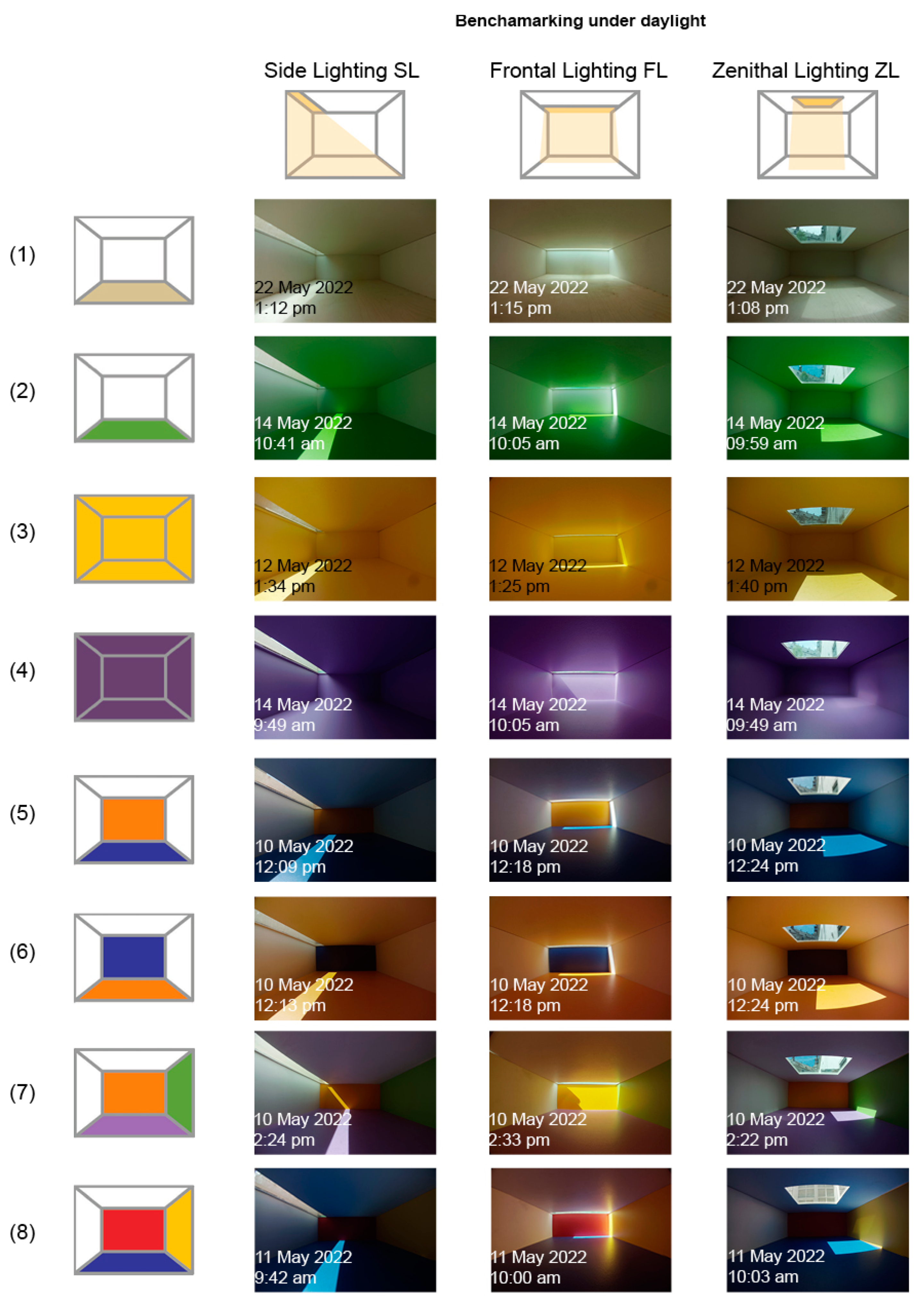
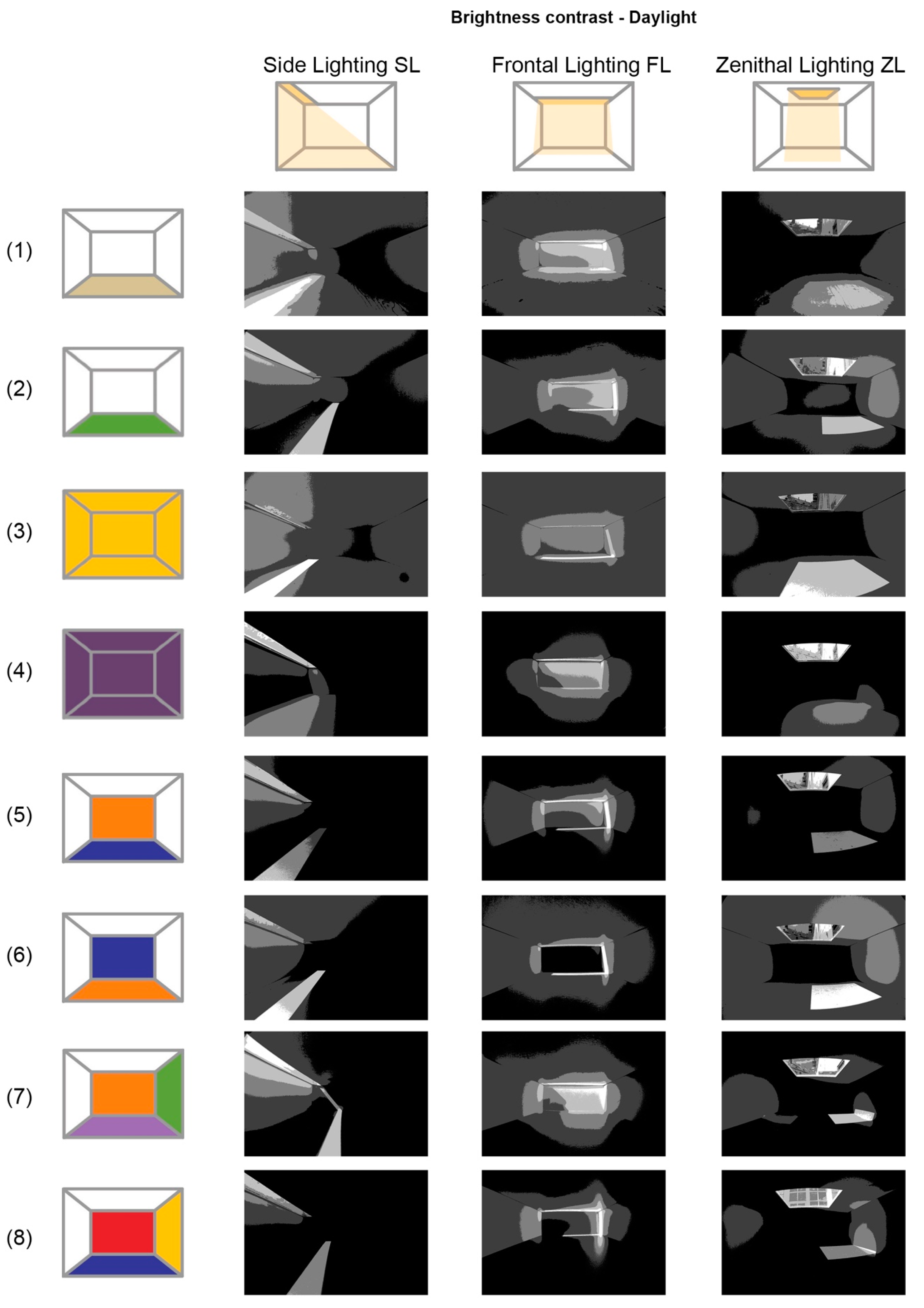
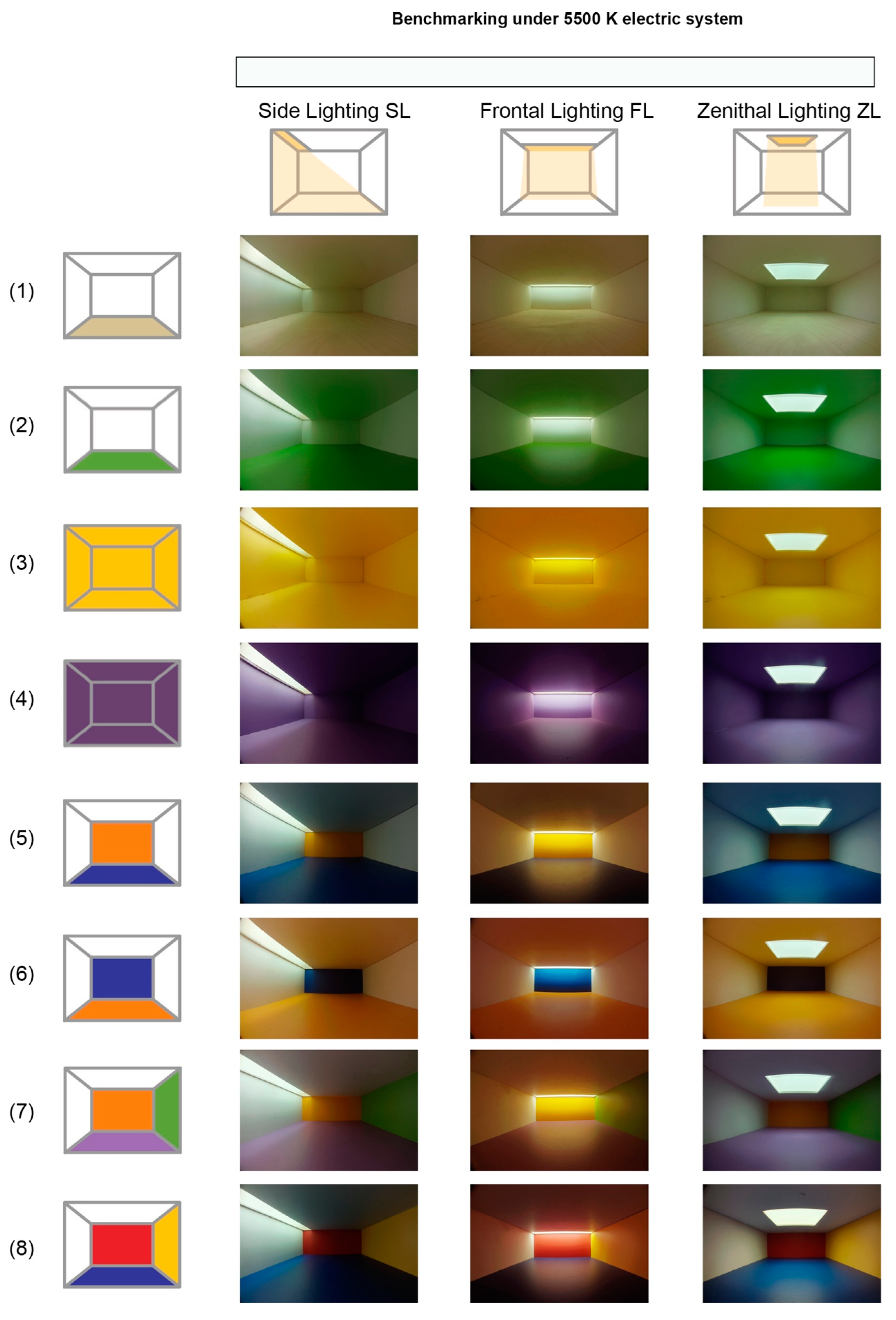

| SC Configuration | Lighting Strategy | Date | Hour | CCT Source | Exterior Illuminance (Ev) |
|---|---|---|---|---|---|
| (1) Achromatic | ST | 22-May | 01:12 PM | 5311 | 43,956 |
| FT | 22-May | 01:15 PM | 5299 | 44,699 | |
| ZL | 22-May | 01:08 PM | 5315 | 43,612 | |
| (2) Green Floor | ST | 14-May | 10:41 AM | 5533 | 42,250 |
| FT | 14-May | 10:05 AM | 5482 | 40,153 | |
| ZL | 14-May | 09:59 AM | 5404 | 32,795 | |
| (3) Monochromatic-Yellow | ST | 12-May | 01:34 PM | 5253 | 61,610 |
| FT | 12-May | 01:25 PM | 5315 | 60,440 | |
| ZL | 12-May | 01:40 PM | 5311 | 65,660 | |
| (4) Monochromatic-Violet | ST | 14-May | 09:49 AM | 5304 | 41,860 |
| FT | 14-May | 10:05 AM | 5482 | 39,170 | |
| ZL | 14-May | 09:49 AM | 5304 | 30,370 | |
| (5) Complementary 1 | ST | 10-May | 12:09 PM | 5314 | 68,956 |
| FT | 10-May | 12:18 PM | 5344 | 67,934 | |
| ZL | 10-May | 12:24 PM | 5332 | 69,124 | |
| (6) Complementary 2 | ST | 10-May | 12:13 PM | 5398 | 68,672 |
| FT | 10-May | 12:18 PM | 5401 | 67,934 | |
| ZL | 10-May | 12:24 PM | 5399 | 69,124 | |
| (7) Triad-Primary | ST | 10-May | 02:24 PM | 5235 | 70,439 |
| FT | 10-May | 02:33 PM | 5212 | 69,284 | |
| ZL | 10-May | 02:22 PM | 5240 | 69,511 | |
| (8) Triad Secondary | ST | 11-May | 09:42 PM | 5231 | 40,943 |
| FT | 11-May | 10:00 AM | 5270 | 39,152 | |
| ZL | 11-May | 10:03 AM | 5283 | 32,488 |
References
- Meerwein, G.; Rodeck, B.; Mahnke, F.H. Color—Communication in Architectural Space, 4; Birkhäuser: Basel, Switzerland, 2007. [Google Scholar]
- National Resources Canada. Retrofitting. 2018. Available online: https://natural-resources.canada.ca/energy-efficiency/buildings/existing-buildings/retrofitting/20707 (accessed on 26 June 2024).
- Jaglarz, A. Perception of Color in Architecture and Urban Space. Buildings 2023, 13, 2000. [Google Scholar] [CrossRef]
- Thampanichwat, C.; Bunyarittikit, S.; Moorapun, C.; Phaibulputhipong, P. A Content Analysis of Architectural Atmosphere Influencing Mindfulness through the Lens of Instagram. Sustainability 2023, 15, 10063. [Google Scholar] [CrossRef]
- Altomonte, S. Daylight for Energy Savings and Psycho-Physiological Well-Being in Sustainable Built Environments. J. Sustain. Dev. 2009, 1, 3–16. [Google Scholar] [CrossRef]
- Tsangrassoulis, A.; Kontadakis, A.; Doulos, L. Assessing Lighting Energy Saving Potential from Daylight Harvesting in Office Buildings Based on Code Compliance & Simulation Techniques: A Comparison. Procedia Environ. Sci. 2017, 38, 420–427. [Google Scholar] [CrossRef]
- Nur, Y.A.; Yoon, G.; Sato, T. Energy savings evaluation of enhanced classroom daylighting utilization. Energy Build. 2024, 312, 114179. [Google Scholar] [CrossRef]
- National Resources Canada. Make Your Building More Energy Efficient. 2022. Available online: https://natural-resources.canada.ca/stories/spotlight-energy-efficiency/make-your-building-more-energy-efficient (accessed on 7 January 2025).
- Lighting Choices to Save You Money, Energy.Gov. Available online: https://www.energy.gov/energysaver/lighting-choices-save-you-money (accessed on 7 January 2025).
- Why Choose ENERGY STAR Certified LED Lighting?|ENERGY STAR. Available online: https://www.energystar.gov/products/lighting_fans/light_fixtures/why_choose_energy_star_qualified_led_lighting (accessed on 6 January 2025).
- Xia, S.; Zhao, Q.; Ji, J.; Wu, R.; Chen, L.; Yin, Y.; Liu, Q. Impact of Water-Based Coating Substitution on VOCs Emission Characteristics for the Surface-Coating Industries and Policy Effectiveness: A Case Study in Jiangsu Province, China. Atmosphere 2023, 14, 662. [Google Scholar] [CrossRef]
- de Kort, J.M.A.; Gauvin, F.; Loomans, M.G.L.C.; Brouwers, H.J.H. Emission rates of bio-based building materials, a method description for qualifying and quantifying VOC emissions. Sci. Total Environ. 2023, 905, 167158. [Google Scholar] [CrossRef]
- Ghobakhloo, S.; Khoshakhlagh, A.H.; Morais, S.; Tehrani, A.M. Exposure to Volatile Organic Compounds in Paint Production Plants: Levels and Potential Human Health Risks. Toxics 2023, 11, 111. [Google Scholar] [CrossRef] [PubMed]
- Knoop, M.; Stefani, O.; Bueno, B.; Matusiak, B.; Hobday, R.; Wirz-Justice, A.; Martiny, K.; Kantermann, T.; Aarts, M.; Zemmouri, N.; et al. Daylight: What makes the difference? Light. Res. Technol. 2020, 52, 423–442. [Google Scholar] [CrossRef]
- Blume, C.; Garbazza, C.; Spitschan, M. Effects of light on human circadian rhythms, sleep and mood. Somnologie 2019, 23, 147–156. [Google Scholar] [CrossRef] [PubMed]
- Boyce, P.R. Human Factors in Lighting, 3rd ed.; CRC Press: Boca Raton, FL, USA, 2014. [Google Scholar]
- Kwallek, N.; Lewis, C.M.; Robbins, A.N.N.S. Effects of Office Interior Color on Workers’ Mood and Productivity. Percept. Mot. Ski. 1988, 66, 123–128. [Google Scholar] [CrossRef]
- Küller, R.; Mikellides, B.; Janssens, J. Color, arousal, and performance—A comparison of three experiments. Color Res. Appl. 2009, 34, 141–152. [Google Scholar] [CrossRef]
- Veitch, J.; Newsham, G.; Boyce, P.; Jones, C. Lighting appraisal, well-being and performance in open-plan offices: A linked mechanisms approach. Light. Res. Technol. 2008, 40, 133–151. [Google Scholar] [CrossRef]
- Küller, R.; Ballal, S.; Laike, T.; Mikellides, B.; Tonello, G. The impact of light and colour on psychological mood: A cross-cultural study of indoor work environments. Ergonomics 2006, 49, 1496–1507. [Google Scholar] [CrossRef] [PubMed]
- Hegde, A.L.; Rogers, J.M. Effects of Light, Illuminance and Color on Subjective Impression Rankings. Des. Princ. Pract. Int. J.-Annu. Rev. 2013, 6, 33–44. [Google Scholar] [CrossRef]
- Poirier, G.; Demers, C.M.H.; Potvin, A. Wood Perception in Daylit Interior Spaces: An Experimental Study Using Scale Models and Questionnaires. BioResources 2019, 14, 1941–1968. [Google Scholar] [CrossRef]
- Hidayetoglu, M.L.; Yildirim, K.; Akalin, A. The effects of color and light on indoor wayfinding and the evaluation of the perceived environment. J. Environ. Psychol. 2012, 32, 50–58. [Google Scholar] [CrossRef]
- Min, Y.H.; Ha, M. Contribution of colour-zoning differentiation to multidimensional spatial knowledge acquisition in symmetrical hospital wards. Indoor Built Environ. 2020, 30, 1420326X2090949. [Google Scholar] [CrossRef]
- Jansen-Osmann, P.; Wiedenbauer, G. Wayfinding Performance in and the Spatial Knowledge of a Color-coded Building for Adults and Children. Spat. Cogn. Comput. 2004, 4, 337–358. [Google Scholar] [CrossRef]
- Gerhardsson, K.M.; Laike, T.; Johansson, M. Leaving lights on—A conscious choice or wasted light? Use of indoor lighting in Swedish homes. Indoor Built Environ. 2020, 30, 745–762. [Google Scholar] [CrossRef]
- Schauss, A.G. Tranquilizing Effect of Color Reduces Aggressive Behavior and Potential Violence. Orthomol. Psychiatry 1979, 8, 218–221. [Google Scholar]
- Pellegrini, R.J.; Schauss, A.G.; Miller, M.E. Room Color and Aggression in A Criminal Detention Holding Cell: A Test of the “Tranquilizing Pink” Hypothesis. J. Orthomol. Psychiatry 1981, 10, 174–181. [Google Scholar]
- Stephen, K.; Kaplan, R. Cognition and Environment: Functioning in an Uncertain World; Praeger: New York, NY, USA, 1982. [Google Scholar]
- Kuijsters, A.; Redi, J.; de Ruyter, B.; Seuntiëns, P.; Heynderickx, I. Affective ambiences created with lighting for older people. Light. Res. Technol. 2015, 47, 859–875. [Google Scholar] [CrossRef]
- Jafarian, H.; Demers, C.; Blanchet, P.; Landry, V. Lighting Ambiances and Materialities of Wood in Architecture “A Comparative Evaluation of the Quality of Spaces in Relation to Interior Finishes”, Université Laval. 2016. Available online: https://corpus.ulaval.ca/jspui/handle/20.500.11794/27262 (accessed on 1 April 2019).
- Demers, C.M.H. The Sanctuary of Art: Images in the Assessment and Design of Light in Architecture. Ph.D. Thesis, University of Cambridge, Cambridge, UK, 1997. [Google Scholar]
- Rockcastle, S. Perceptual Dynamics of Daylight in Architecture. Ph.D. Thesis, École Polytechnique Fédérale de Lausanne, Lausanne, Switzerland, 2017. [Google Scholar]
- Demers, C.M.H. Assessing Light in Architecture: A Numerical Procedure for a Qualitative and Quantitative Analysis; CIE (Commission Internationale de l’Éclairage): Venice, Italy, 2006; p. 8. [Google Scholar]
- Teleworking in the COVID-19 Pandemic: Trends and Prospects, OECD. Available online: https://www.oecd.org/en/publications/2021/09/teleworking-in-the-covid-19-pandemic-trends-and-prospects_5b0f89ee.html (accessed on 21 November 2023).
- Lecours, A.; Gilbert, M.-H.; Boucher, N.; Vincent, C. The Influence of Teleworking in a Pandemic Context on the Work Experience of Individuals with Physical Disabilities: A Quebec Qualitative Study. J. Occup. Rehabil. 2023, 33, 375–388. [Google Scholar] [CrossRef] [PubMed]
- Kiko, M.; Coulombel, N.; Poulhès, A.; Seregina, T.; Tremblin, G. Evaluation of Direct and Indirect Effects of Teleworking on Mobility: The Case of Paris. Transp. Res. Rec. 2023, 2678, 865–878. [Google Scholar] [CrossRef]
- Groat, L.N.; Wang, D. Architectural Research Methods, 2nd ed.; John Wiley & Sons, Inc.: Hoboken, NJ, USA, 2013; Available online: https://nexosarquisucr.wordpress.com/wp-content/uploads/2016/03/architecturalresearchmethods-groat_wang.pdf (accessed on 10 February 2025).
- Cruickshank, L.; Coupe, G.; Hennessy, D. Co-Design: Fundamental Issues and Guidelines for Designers: Beyond the Castle Case Study. Swed. Des. Res. J. 2016, 9, 46. [Google Scholar] [CrossRef]
- Evans, M.; Terrey, N. Co-design with citizens and stakeholders. In Evidence-Based Policy Making in the Social Sciences: Methods That Matter; Bristol University Press: Bristol, UK, 2016; pp. 243–262. [Google Scholar] [CrossRef]
- Carthy, S.; Cormican, K.; Sampaio, S. Knowing me knowing you: Understanding user involvement in the design process. Procedia Comput. Sci. 2021, 181, 135–140. [Google Scholar] [CrossRef]
- Russell, J.A.; Mehrabian, A. Evidence for a Three-Factor Theory of Emotions. J. Res. Personal. 1977, 11, 273–294. [Google Scholar] [CrossRef]
- Russell, J.A.; Pratt, G. A Description of the Affective Quality Attributed to Environments. J. Personal. Soc. Psychol. 1980, 38, 311–322. [Google Scholar] [CrossRef]
- Witzel, C.; Gegenfurtner, K. Chromatic Contrast Sensitivity. In Encyclopedia of Color Science and Technology; Luo, R., Ed.; Springer: Berlin/Heidelberg, Germany, 2015; pp. 1–7. [Google Scholar] [CrossRef]
- Albers, J. Interaction of Color. Leonardo 1973, 6, 272. [Google Scholar] [CrossRef]
- Itten, J. Art de la Couleur: Approche Subjective et Description Objective de l’art; Edition Ab: Paris, France, 1961. [Google Scholar]
- Valdez, P.; Mehrabian, A. Effects of Color on Emotions. J. Exp. Psychol. Gen. 1994, 123, 394–409. [Google Scholar] [CrossRef] [PubMed]
- Divers, E. Theory to practice: Pleasure-Arousal-Dominance (PAD) theory for architectural color design. Color Res. Appl. 2023, 48, 445–452. [Google Scholar] [CrossRef]
- Chen, Y.; Yang, J.; Yu, L.; Westland, S.; Wang, H. The multiple characteristics of specific associations from words to colors. Color Res. Appl. 2023, 48, 139–150. [Google Scholar] [CrossRef]
- Dael, N.; Perseguers, M.-N.; Marchand, C.; Antonietti, J.-P.; Mohr, C. Put on that colour, it fits your emotion: Colour appropriateness as a function of expressed emotion. Q. J. Exp. Psychol. 2016, 69, 1619–1630. [Google Scholar] [CrossRef] [PubMed]
- AL-Ayash, A.; Kane, R.T.; Smith, D.; Green-Armytage, P. The influence of color on student emotion, heart rate, and performance in learning environments. Color Res. Appl. 2016, 41, 196–205. [Google Scholar] [CrossRef]
- Wilms, L.; Oberfeld, D. Color and emotion: Effects of hue, saturation, and brightness. Psychol. Res. 2018, 82, 896–914. [Google Scholar] [CrossRef]
- Gao, X.P.; Xin, J.H. Investigation of human’s emotional responses on colors. Color Res. Appl. 2006, 31, 411–417. [Google Scholar] [CrossRef]
- Gao, X.-P.; Xin, J.H.; Sato, T.; Hansuebsai, A.; Scalzo, M.; Kajiwara, K.; Guan, S.-S.; Valldeperas, J.; Lis, M.J.; Billger, M. Analysis of cross-cultural color emotion. Color Res. Appl. 2007, 32, 223–229. [Google Scholar] [CrossRef]
- Rockcastle, S.; Amundadottir, M.L.; Andersen, M. Contrast measures for predicting perceptual effects of daylight in architectural renderings. Light. Res. Technol. 2017, 49, 882–903. [Google Scholar] [CrossRef]
- Espinoza-Sanhueza, C.; Hébert, M.; Lalonde, J.-F.; Demers, C.M.H. Biophilic analogous patterns for light-responsive architecture during polar night: Examining the photobiological effects of electrical lighting on surface colour configuration. Build. Environ. 2024, 249, 111125. [Google Scholar] [CrossRef]
- Espinoza-Sanhueza, C.; Hébert, M.; Lalonde, J.-F.; Demers, C.M. Dataset of images for visual and non-visual analysis of colour applications in architecture. Data Brief 2024, 55, 110755. [Google Scholar] [CrossRef]
- Waveshare. “RPi Camera (I), Fisheye Lens”. Available online: https://www.waveshare.com/rpi-camera-i.htm (accessed on 29 February 2024).
- Raspberry Pi Foundation, Camera—About Camera Modules, Raspberry Pi Documentation. Available online: https://www.raspberrypi.com/documentation/accessories/camera.html (accessed on 20 March 2024).
- The Raspberry Pi Foundation, Teach, Learn, and Make with Raspberry Pi, Raspberry Pi. Available online: https://www.raspberrypi.org/ (accessed on 10 February 2021).
- Lau, J. Use of scale models for appraising lighting quality. Light. Res. Technol. 1972, 4, 254–262. [Google Scholar] [CrossRef]
- Bodart, M.; Deneyer, A.; De Herde, A.; Wouters, P. A Guide for Building Daylight Scale Models. Archit. Sci. Rev. 2007, 50, 31–36. [Google Scholar] [CrossRef]
- Demers, C.M. Light: The Power of Images—A Design for Architectural Creation. In Proceedings of the 30th Annual Conference of the EDRA, Orlando, FL, USA, 2–6 June 1999. [Google Scholar]
- Potočnik, J.; Košir, M. Influence of commercial glazing and wall colours on the resulting non-visual daylight conditions of an office. Build. Environ. 2020, 171, 106627. [Google Scholar] [CrossRef]
- Jakubiec, J.A. Data-Driven Selection of Typical Opaque Material Reflectances for Lighting Simulation. Leukos 2022, 19, 176–189. [Google Scholar] [CrossRef]
- Chevreul, M. The Laws of Contrast of Colour; Routledge, Warne and Routledge: London, UK; New York, NY, USA, 1861. [Google Scholar]
- Parsaee, M.; Demers, C.M.H.; Lalonde, J.-F.; Potvin, A.; Inanici, M.; Hébert, M. Human-centric lighting performance of shading panels in architecture: A benchmarking study with lab scale physical models under real skies. Sol. Energy 2020, 204, 354–368. [Google Scholar] [CrossRef]
- Espinoza-Sanhueza, C.; Hébert, M.; Lalonde, J.-F.; Demers, C.M. Exploring light and colour patterns for remote biophilic northern architecture. Indoor Built Environ. 2023, 33, 359–376. [Google Scholar] [CrossRef]
- DiLaura, D.L.; Houser, K.W.; Mistrick, R.G.; Steffy, G.R. The IESNA Lighting Handbook, 10th ed.; Illuminating Engineering: New York, NY, USA, 2011. [Google Scholar]
- Hoang, K.; Peters, T. Optimisation of Housing Design Options for Human-Centric Lighting. Impacts of architectural parameters on daylight. In Proceedings of the PLEA 2022 Santiago Will Cities Survive? Santiago, Chile, 22–25 November 2022; p. 1118. Available online: https://plea2022.org/wp-content/uploads/2023/03/PROCEEDINGS-ONSITE-FINAL-MARZO.pdf (accessed on 10 February 2025).
- DeKay, M.; Brown, G. Sun, Wind and Light; John Wiley: Hoboken, NJ, USA, 2014. [Google Scholar]
- Gagné, V.; Turgeon, R.; Jomphe, V.; Demers, C.M.H.; Hébert, M. Evaluation of the effects of blue-enriched white light on cognitive performance, arousal, and overall appreciation of lighting. Front. Public Health 2024, 12, 1390614. [Google Scholar] [CrossRef] [PubMed]
- Konica Minolta, CL-200A Chroma Meter, Konica Minolta Sensing. 2021. Available online: https://sensing.konicaminolta.us/us/products/cl-200a-chroma-meter/ (accessed on 19 March 2021).
- Chinchero, H.; Alonso, J.; Ortiz, H. LED lighting systems for smart buildings: A review. IET Smart Cities 2020, 2, 126–134. [Google Scholar] [CrossRef]
- Philips, Smart Lighting, Philips Hue. 2018. Available online: https://www.philips-hue.com/en-us (accessed on 18 March 2021).
- Wyszecki, G.; Stiles, W.S. Color Science: Concepts and Methods, Quantitative Data and Formulae, 1st ed.; John Wiley & Sons, Inc.: New York, NY, USA, 1967. [Google Scholar]
- Zheng, X. Insights to Current Lighting Technologies and Low Environmental Impact Artificial Lighting. In Renewable Energy and Sustainable Technologies for Building and Environmental Applications: Options for a Greener Future; Ahmad, M.I., Ismail, M., Riffat, S., Eds.; Springer International Publishing: Cham, Switzerland, 2016; pp. 87–105. [Google Scholar] [CrossRef]
- Veitch, J.A. Imagining the future of office lighting: Smart, sustainable, solid-state. Light Off. Newsl. Indian Soc. Og Light. Eng. 2013, 4, 10–22. [Google Scholar]
- Anter, K.F.; Klarén, U.; Anter, E. Colour & Light: Spatial Experience, 2nd ed.; Routledge, Taylor & Francis Group: London, UK, 2017. [Google Scholar]
- Parsaee, M. RaspiCamera. 2022. Available online: https://github.com/parsaeemojtaba/RaspiCamera (accessed on 10 February 2025).
- Python Software Foundation, Opencv-Python: Wrapper Package for OpenCV Python Bindings. Available online: https://github.com/skvark/opencv-python (accessed on 24 August 2022).
- Reinhard, E.; Ward, G.; Pattanaik, S.; Debevec, P.; Heidrich, W.; Myszkowski, K. High Dynamic Range Imaging: Acquisition, Display and Image-Based Lighting, 2nd ed.; Morgan Kaufmann: Burlington, NJ, USA, 2010. [Google Scholar]
- Yoshida, A.; Blanz, V.; Myszkowski, K.; Seidel, H.-P. Perceptual Evaluation of Tone Mapping Operators with Real-World Scenes. In Human Vision and Electronic Imaging X, Proceedings of the Electronic Imaging 2005, San Jose, CA, USA, 16–20 January 2005; Rogowitz, B.E., Pappas, T.N., Daly, S.J., Eds.; SPIE: Bellingham, WA USA, 2005; p. 192. Available online: https://www.spiedigitallibrary.org/conference-proceedings-of-spie/5666.toc (accessed on 10 February 2025). [CrossRef]
- Tai, N.-C.; Inanici, M. Space perception and luminance contrast: Investigation and design applications through perceptually based computer simulations. In Proceedings of the 2010 Spring Simulation Multiconference, Orlando, FL, USA, 11–15 April 2010. [Google Scholar] [CrossRef]
- Adobe, Adobe InDesign. 2023. Available online: https://www.adobe.com/ca/products/indesign/free-trial-download.html (accessed on 10 February 2025).
- Mahnke, F.H. Color, Environmental and Human Response: An Interdisciplinary Understanding of Color and Its Use as a Benefitial Element in the Design of the Architectural Environment; John Wiley & Sons, Inc.: New York, NY, USA, 1996. [Google Scholar]
- Joblove, G.H.; Greenberg, D. Color spaces for computer graphics. SIGGRAPH Comput. Graph. 1978, 12, 20–25. [Google Scholar] [CrossRef]
- Microsoft, Microsoft Excel Spreadsheet Software|Microsoft 365. Available online: https://www.microsoft.com/en-us/microsoft-365/excel (accessed on 30 September 2022).
- Demers, C.M. La Couleur Digitale. Couleur et Expression de la Lumière (Partie II); School of Architecture, Université Laval: Quebec City, Canada, 2022. [Google Scholar]
- Béguin, A. Dictionnaire Technique de la Peinture, A; Béguin: Bruxelles, Belgium, 1978. [Google Scholar]
- Le Grand, Y. Optique Physiologique: Lumière et Couleurs, Éditions de la “Revue d’optique”; Masson: Paris, France, 1972. [Google Scholar]
- Adeline, J. Lexique des Termes d’art, Guérin, Montréal. 1997. Available online: http://catalogue.bnf.fr/ark:/12148/cb389959597 (accessed on 21 October 2023).
- de Pracontal, P. Lumière, Matière et Pigment: Principes et Techniques des Procédés Picturaux; Gourcuff Gradenigo: Montreuil, France, 2008. [Google Scholar]
- Bergeon, S.; Curie, P.; Rey, A. Peinture & Dessin Vocabulaire Typologique et Technique, Éditions du Patrimoine; Centre des Monuments Nationaux: Paris, France, 2009; Available online: http://catalogue.bnf.fr/ark:/12148/cb42080040n (accessed on 21 October 2023).
- Bülow-Hübe, H. Subjective reactions to daylight in rooms: Effect of using low-emittance coating on windows. Light. Res. Technol. 1995, 27, 37–44. [Google Scholar] [CrossRef]
- Arsenault, H.; Hébert, M.; Dubois, M.C. Effects of glazing colour type on perception of daylight quality, arousal, and switch-on patterns of electric light in office rooms. Build. Environ. 2012, 56, 223–231. [Google Scholar] [CrossRef]
- Pineault, N.; Dubois, M.-C. Effect of Window Glazing Type on Daylight Quality: Scale Model Study of a Living Room under Natural. Leukos 2013, 5, 83–99. [Google Scholar] [CrossRef]
- Clarke, T.; Costall, A. The emotional connotations of color: A qualitative investigation. Color Res. Appl. 2008, 33, 406–410. [Google Scholar] [CrossRef]
- Jafarian, H.; Demers, C.M.H.; Blanchet, P.; Laundry, V. Effects of interior wood finishes on the lighting ambiance and materiality of architectural spaces. Indoor Built Environ. 2018, 27, 786–804. [Google Scholar] [CrossRef]
- Adobe, Adobe Photoshop. 2020. Available online: https://www.adobe.com/ca/products/photoshop.html (accessed on 10 February 2025).
- Biron, K.; Demers, C.M. Dynamique forme-lumière: Un processus de création et d’analyse de l’espace architectural par modèles maquettes/images. In Proceedings of the Design Research Society International Conference, Montreal, QC, Canada, 7–9 July 2010; Design Research Society: Montreal, QC, Canada, 2010. [Google Scholar] [CrossRef]
- Küller, R. Environmental Assessment from a Neuropsychological Perspective. In Environment, Cognition, and Action: An Integrated Approach; Oxford University Press: New York, NY, USA, 1991; p. 37. [Google Scholar]
- von Goethe, J.W. Theory of Colours; MIT Press: Cambridge, MA, USA, 1810. [Google Scholar]
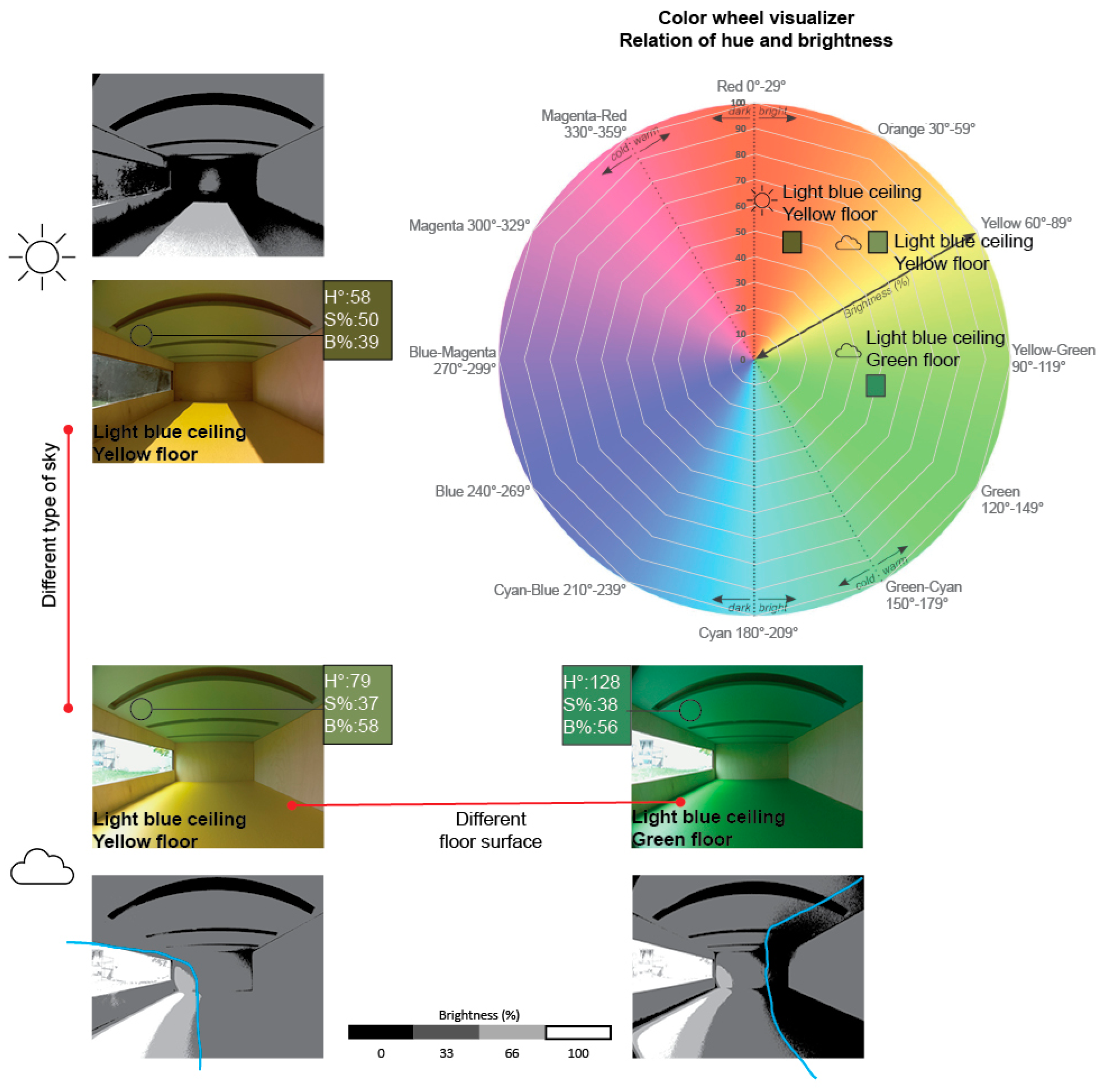
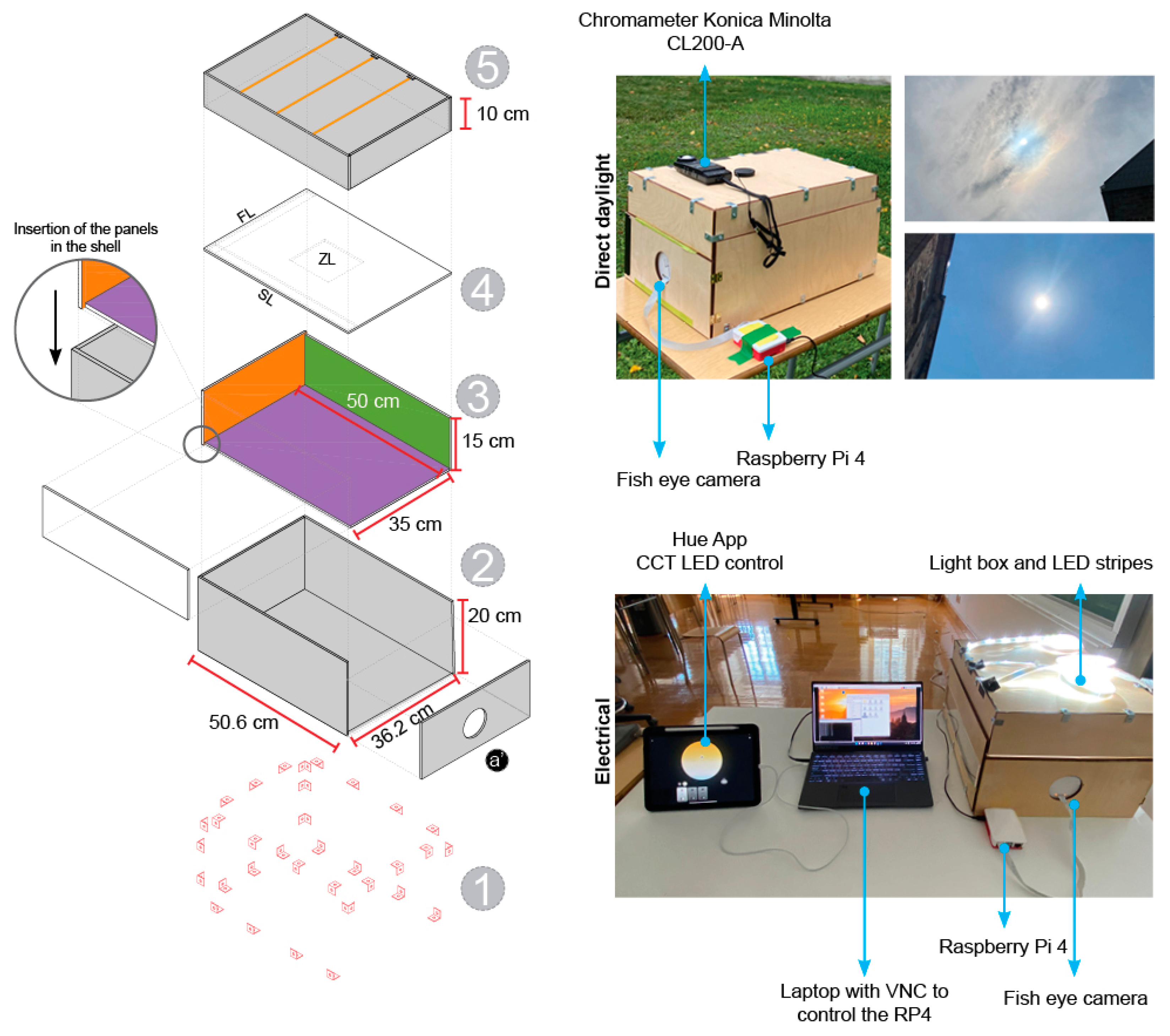
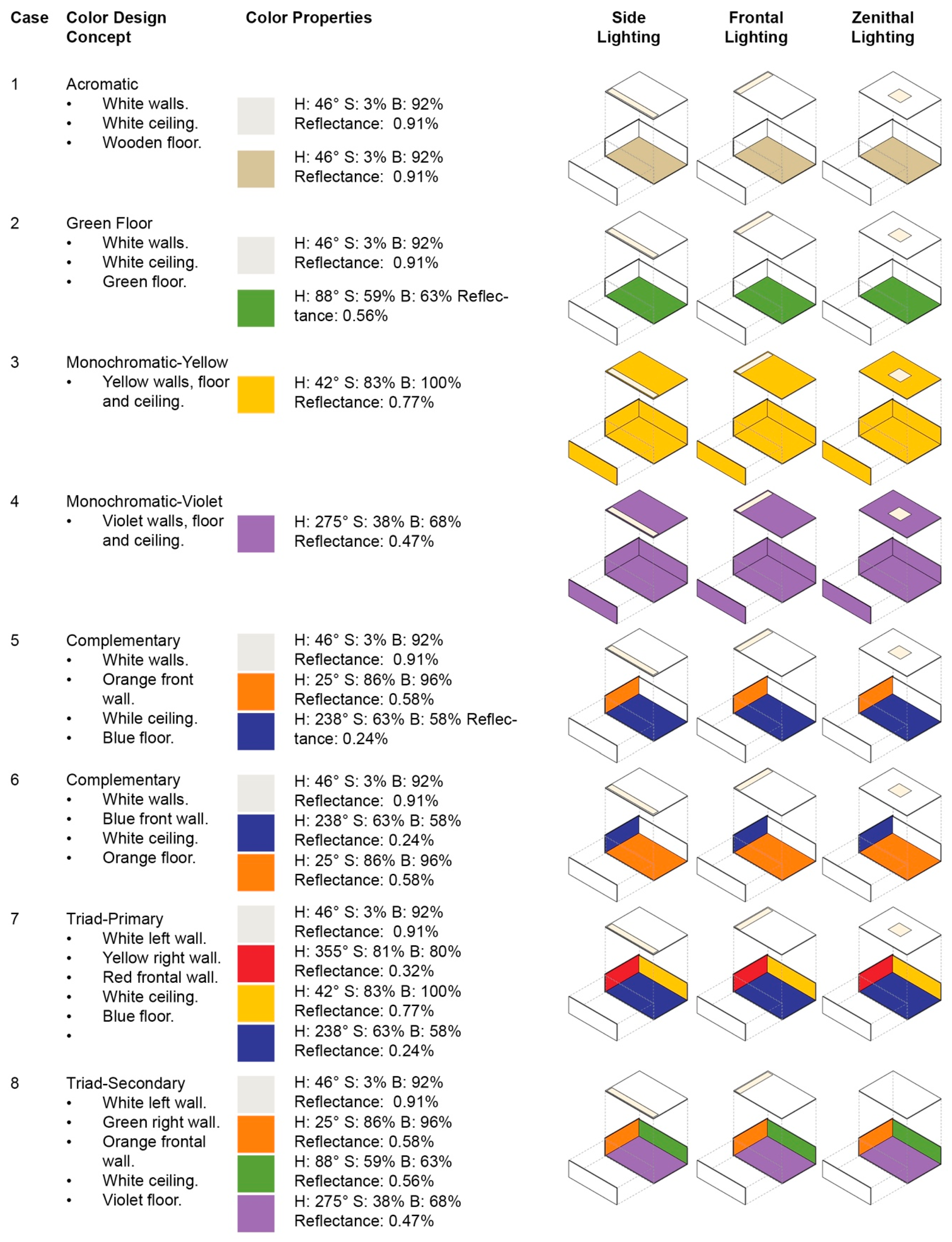
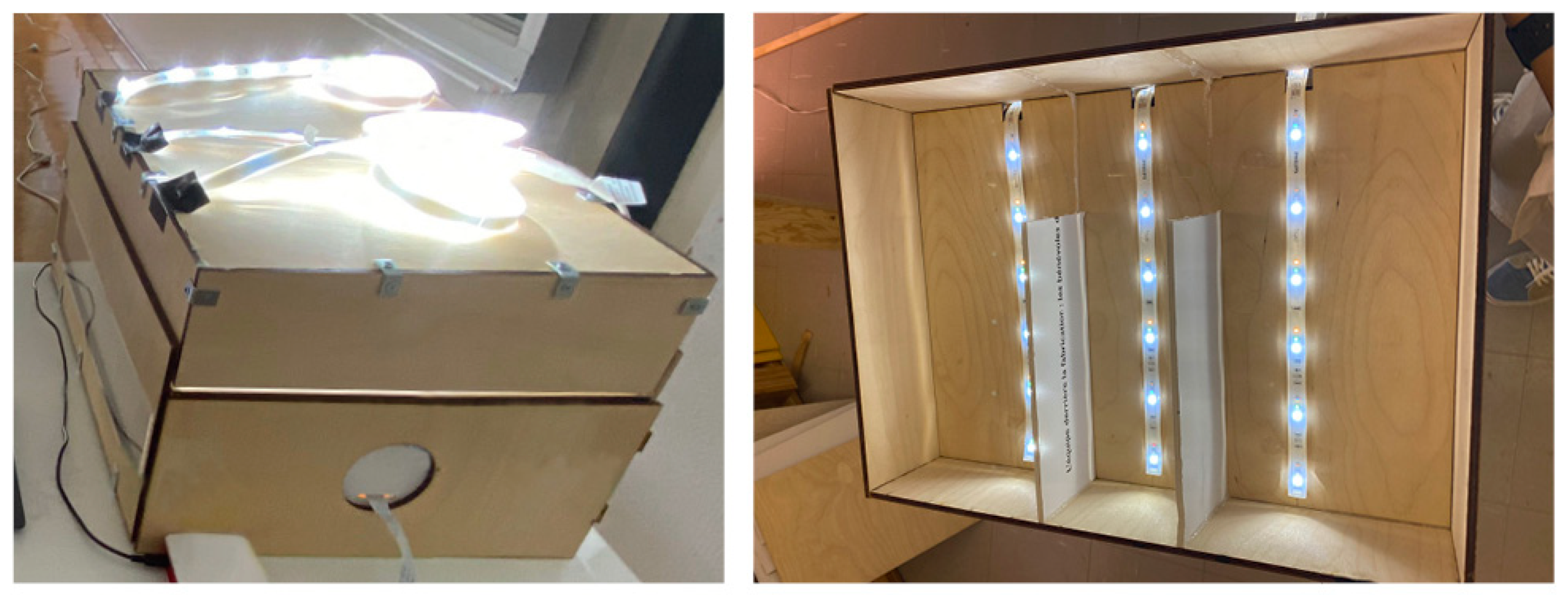
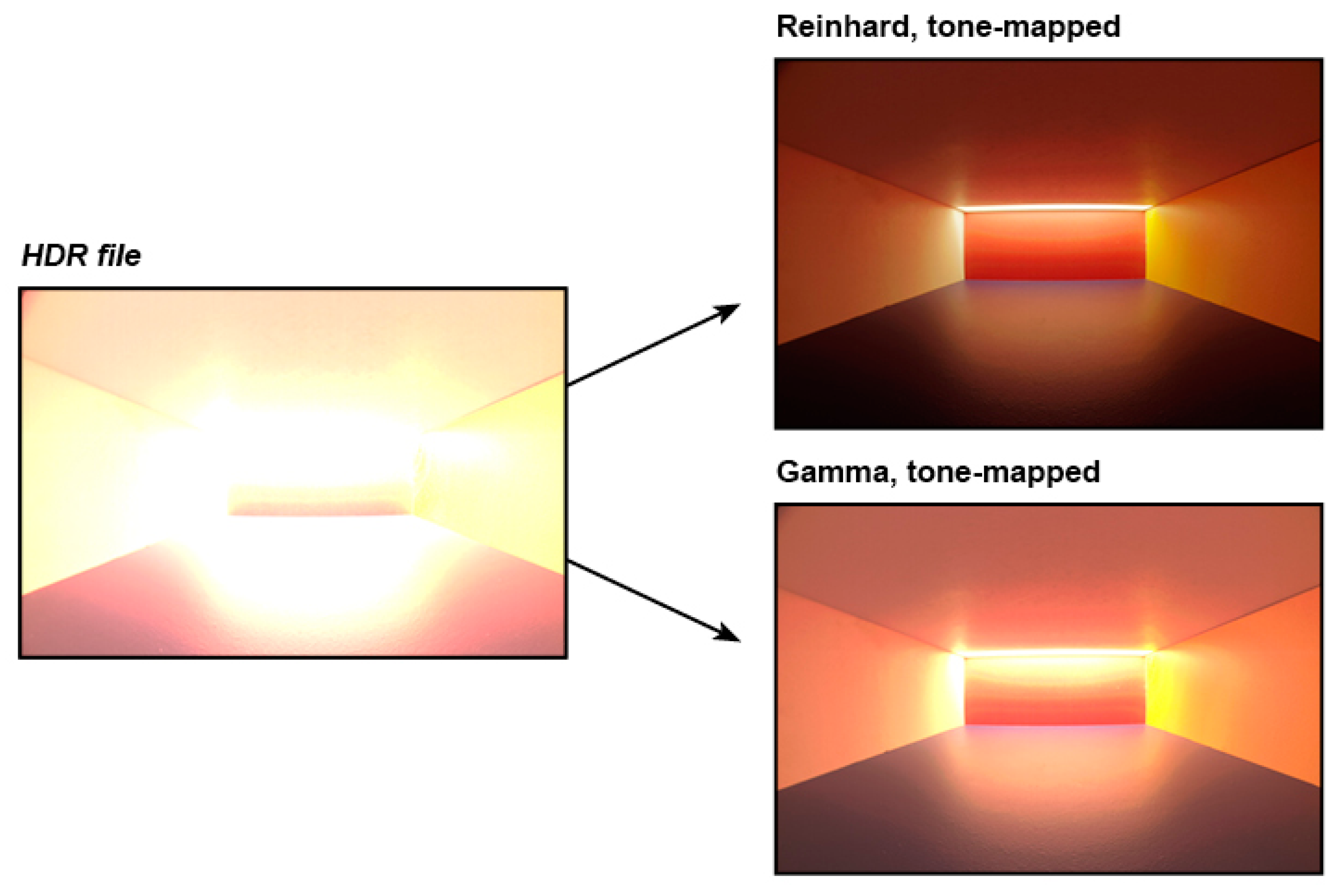
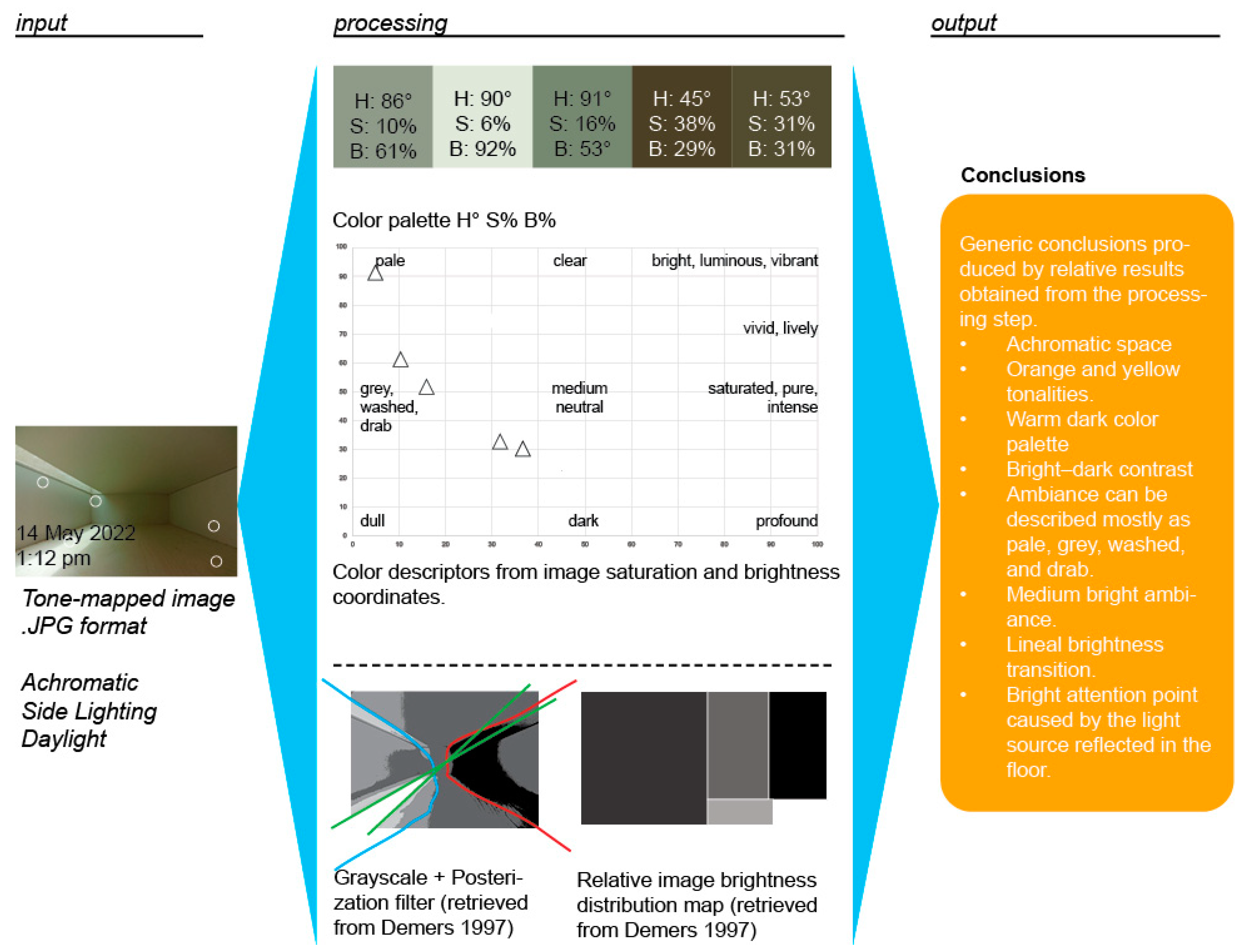
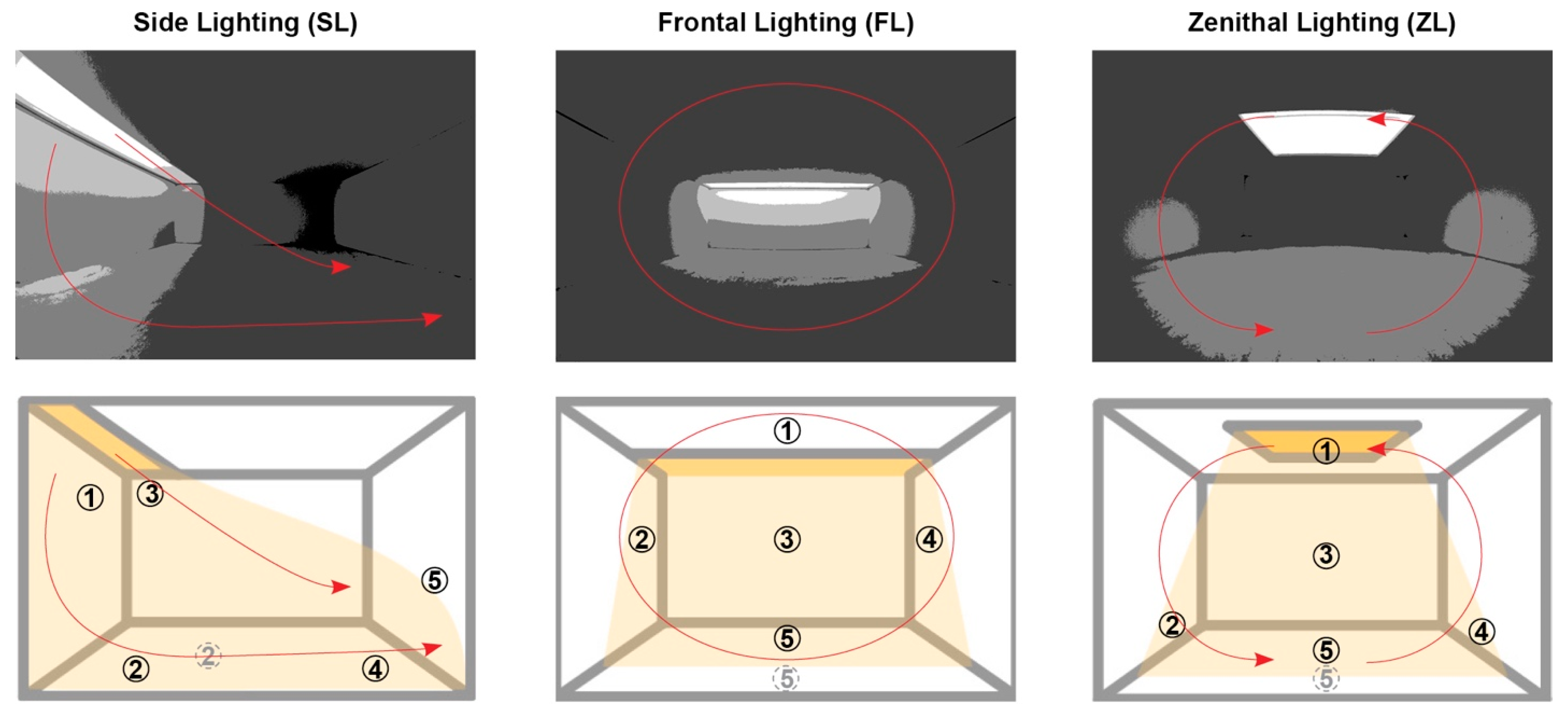

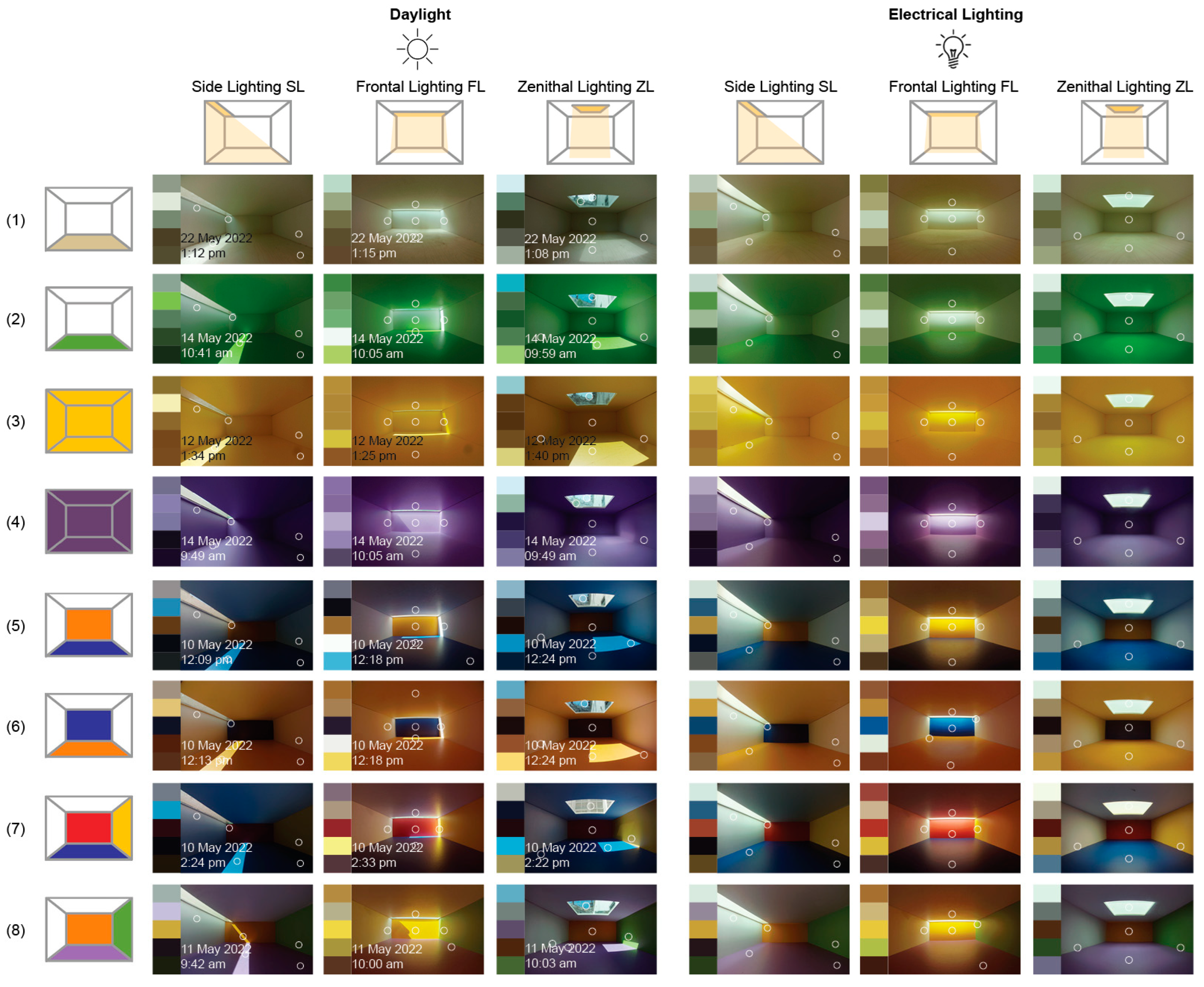

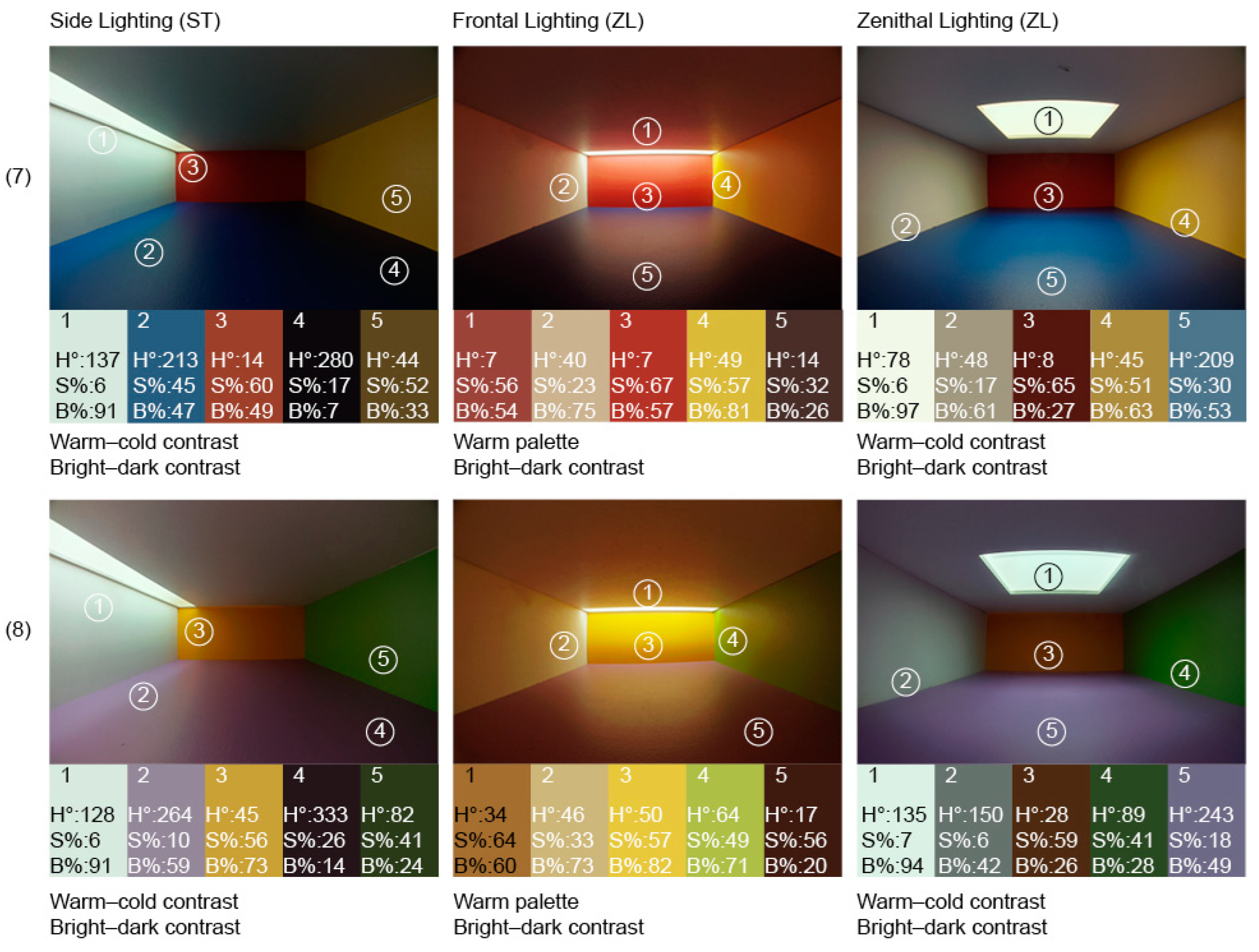


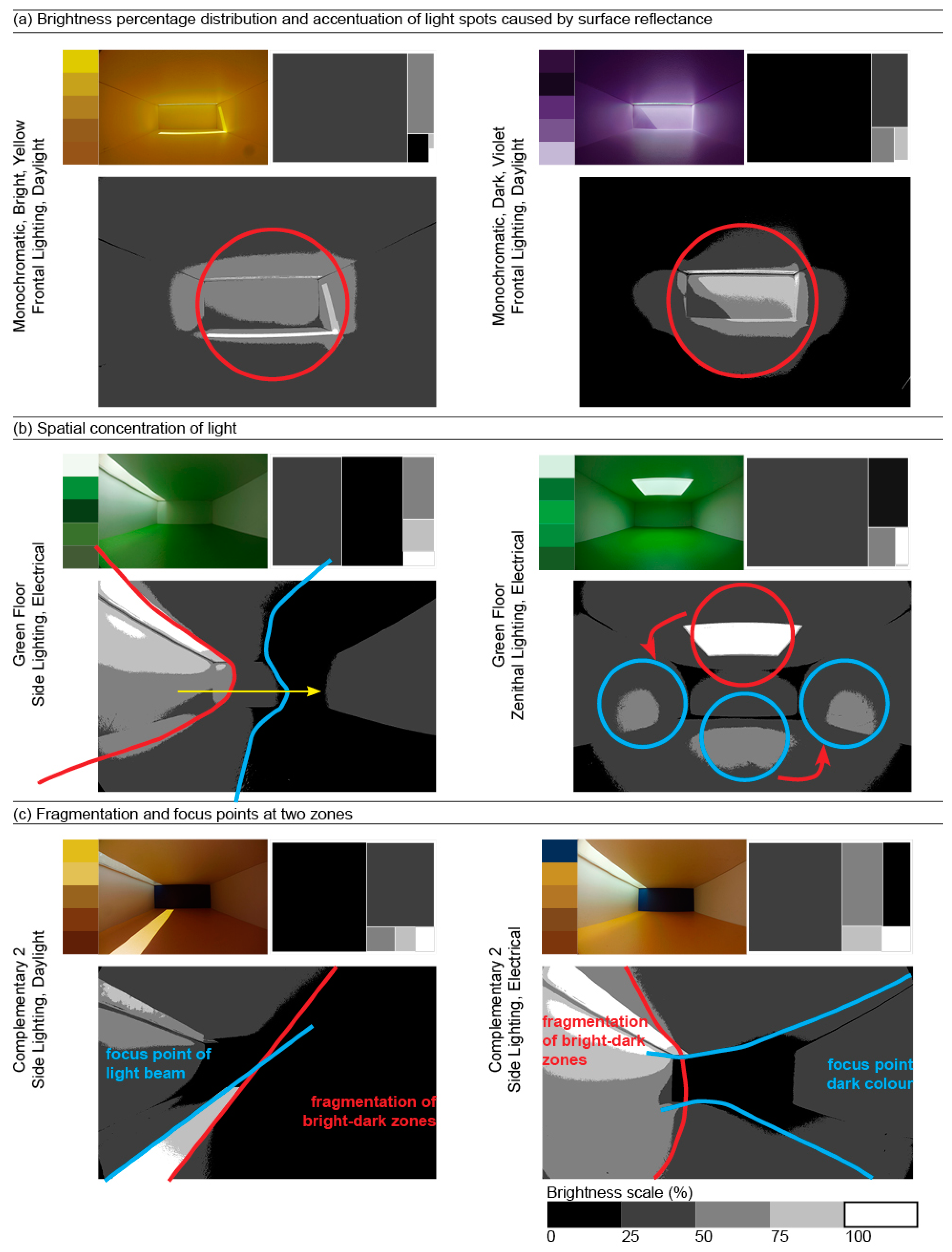

Disclaimer/Publisher’s Note: The statements, opinions and data contained in all publications are solely those of the individual author(s) and contributor(s) and not of MDPI and/or the editor(s). MDPI and/or the editor(s) disclaim responsibility for any injury to people or property resulting from any ideas, methods, instructions or products referred to in the content. |
© 2025 by the authors. Licensee MDPI, Basel, Switzerland. This article is an open access article distributed under the terms and conditions of the Creative Commons Attribution (CC BY) license (https://creativecommons.org/licenses/by/4.0/).
Share and Cite
Espinoza-Sanhueza, C.; Hébert, M.; Lalonde, J.-F.; Demers, C. Evaluating Spatial Attributes of Surface Colors Under Daylight and Electrical Lighting in Sustainable Architecture. Sustainability 2025, 17, 1653. https://doi.org/10.3390/su17041653
Espinoza-Sanhueza C, Hébert M, Lalonde J-F, Demers C. Evaluating Spatial Attributes of Surface Colors Under Daylight and Electrical Lighting in Sustainable Architecture. Sustainability. 2025; 17(4):1653. https://doi.org/10.3390/su17041653
Chicago/Turabian StyleEspinoza-Sanhueza, Carolina, Marc Hébert, Jean-François Lalonde, and Claude Demers. 2025. "Evaluating Spatial Attributes of Surface Colors Under Daylight and Electrical Lighting in Sustainable Architecture" Sustainability 17, no. 4: 1653. https://doi.org/10.3390/su17041653
APA StyleEspinoza-Sanhueza, C., Hébert, M., Lalonde, J.-F., & Demers, C. (2025). Evaluating Spatial Attributes of Surface Colors Under Daylight and Electrical Lighting in Sustainable Architecture. Sustainability, 17(4), 1653. https://doi.org/10.3390/su17041653






